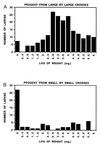Initial frequency of alleles for resistance to Bacillus thuringiensis toxins in field populations of Heliothis virescens
- PMID: 11038613
- PMCID: PMC20471
- DOI: 10.1073/pnas.94.8.3519
Initial frequency of alleles for resistance to Bacillus thuringiensis toxins in field populations of Heliothis virescens
Abstract
The risk of rapid pest adaptation to an insecticide is highly dependent on the initial frequency of resistance alleles in field populations. Because we have lacked empirical estimates of these frequencies, population-genetic models of resistance evolution have relied on a wide range of theoretical estimates. The recent commercialization of genetically engineered cotton that constitutively produces an insecticidal protein derived from the biocontrol agent, Bacillus thuringiensis (Bt) has raised concern that we lack data needed to quantify the risk of insect pests such as Heliothis virescens rapidly adapting to this ecologically valuable class of toxins. By individually mating over 2,000 male H. virescens moths collected in four states to females of a Bt toxin-resistant laboratory strain, and screening F1 and F2 offspring for tolerance of the toxic protein, we were able to directly estimate the field frequency of alleles for resistance as 1.5 x 10(-3). This high initial frequency underscores the need for caution in deploying transgenic cotton to control insect pests. Our single-pair mating technique greatly increases the efficiency of detecting recessive resistance alleles. Because alleles that decrease target site sensitivity to Bt toxins and other insecticides are often recessive, this technique could be useful in estimating resistance allele frequencies in other insects exposed to transgenic insecticidal crops or conventional insecticides.
Figures


Similar articles
-
Broad-spectrum resistance to Bacillus thuringiensis toxins in Heliothis virescens.Proc Natl Acad Sci U S A. 1992 Sep 1;89(17):7986-90. doi: 10.1073/pnas.89.17.7986. Proc Natl Acad Sci U S A. 1992. PMID: 11607319 Free PMC article.
-
An empirical test of the F2 screen for detection of Bacillus thuringiensis-resistance alleles in tobacco budworm (Lepidoptera: Noctuidae).J Econ Entomol. 2008 Aug;101(4):1406-14. doi: 10.1603/0022-0493(2008)101[1406:aetotf]2.0.co;2. J Econ Entomol. 2008. PMID: 18767754
-
Estimating the frequency of Cry1F resistance in field populations of the European corn borer (Lepidoptera: Crambidae).Pest Manag Sci. 2014 May;70(5):725-33. doi: 10.1002/ps.3662. Epub 2013 Oct 25. Pest Manag Sci. 2014. PMID: 24124030
-
Effects of transgenic Bacillus thuringiensis cotton on insecticide use, heliothine counts, plant damage, and cotton yield: A meta-analysis, 1996-2015.PLoS One. 2018 Jul 19;13(7):e0200131. doi: 10.1371/journal.pone.0200131. eCollection 2018. PLoS One. 2018. PMID: 30024919 Free PMC article. Review.
-
Helicoverpa zea and Bt cotton in the United States.GM Crops Food. 2012 Jul-Sep;3(3):213-27. doi: 10.4161/gmcr.20742. Epub 2012 Jul 1. GM Crops Food. 2012. PMID: 22688690 Review.
Cited by
-
Initial frequency of alleles conferring resistance to Bacillus thuringiensis poplar in a field population of Chrysomela tremulae.Proc Biol Sci. 2003 Apr 22;270(1517):791-7. doi: 10.1098/rspb.2002.2317. Proc Biol Sci. 2003. PMID: 12737656 Free PMC article.
-
Seeking the root of insect resistance to transgenic plants.Proc Natl Acad Sci U S A. 1997 Apr 15;94(8):3488-90. doi: 10.1073/pnas.94.8.3488. Proc Natl Acad Sci U S A. 1997. PMID: 11607727 Free PMC article. No abstract available.
-
Evolutionary ecology of insect adaptation to Bt crops.Evol Appl. 2010 Sep;3(5-6):561-73. doi: 10.1111/j.1752-4571.2010.00129.x. Epub 2010 Apr 30. Evol Appl. 2010. PMID: 25567947 Free PMC article.
-
Dual resistance to Bacillus thuringiensis Cry1Ac and Cry2Aa toxins in Heliothis virescens suggests multiple mechanisms of resistance.Appl Environ Microbiol. 2003 Oct;69(10):5898-906. doi: 10.1128/AEM.69.10.5898-5906.2003. Appl Environ Microbiol. 2003. PMID: 14532042 Free PMC article.
-
Molecular Genetic Basis of Lab- and Field-Selected Bt Resistance in Pink Bollworm.Insects. 2023 Feb 17;14(2):201. doi: 10.3390/insects14020201. Insects. 2023. PMID: 36835770 Free PMC article. Review.
References
-
- Georghiou G P, Lagunes-Tejeda A. The Occurrence of Resistance to Pesticides in Arthropods. Rome: Food and Agriculture Organization; 1991.
-
- Metcalf R L. Pestic Sci. 1989;26:333–358.
-
- Talekar N S, Shelton A M. Annu Rev Entomol. 1993;38:275–301.
-
- Gould F. BioScience. 1988;38:26–33.
-
- McGaughey W H, Whalon M E. Science. 1992;258:1451–1455. - PubMed
LinkOut - more resources
Full Text Sources
Other Literature Sources
Miscellaneous

